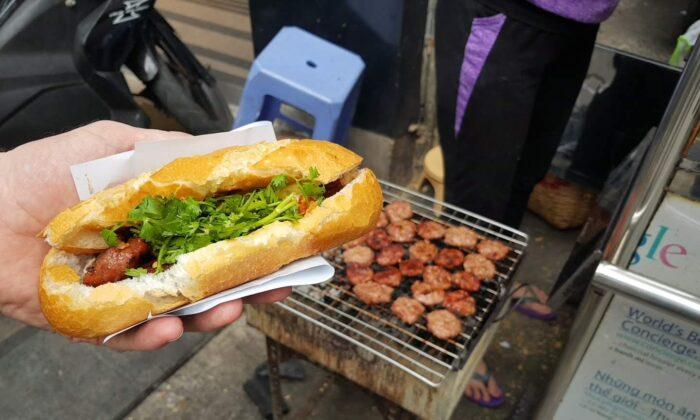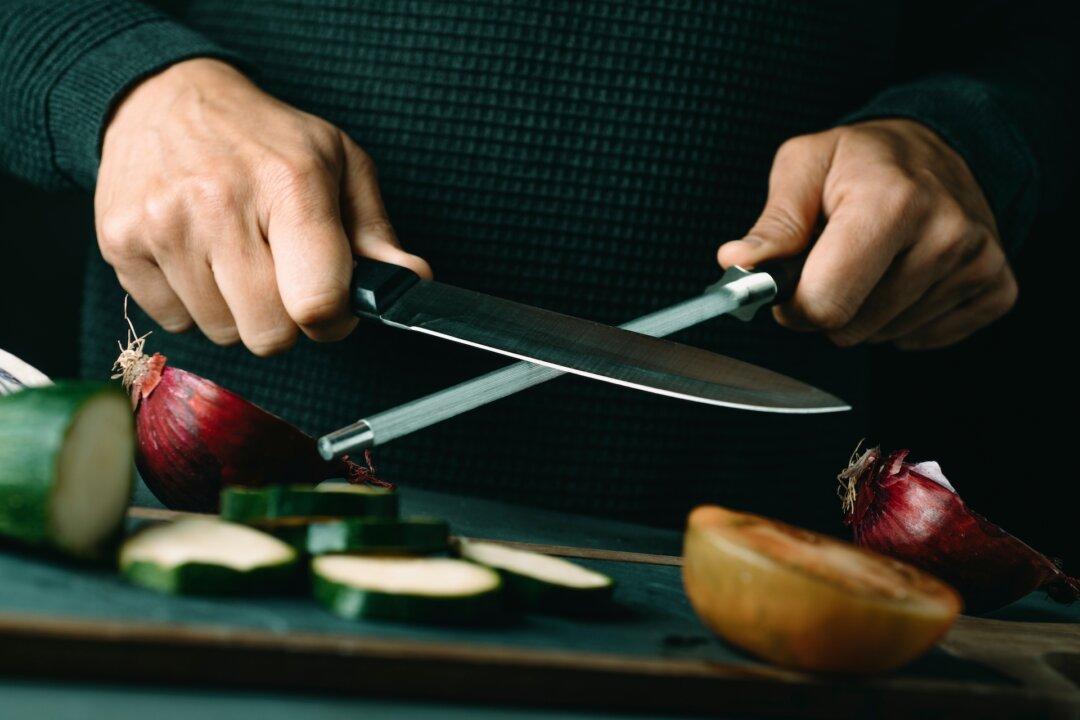In the past, when I thought of a Vietnamese bánh mì, I expected a somewhat universally accepted definition, a traditional composition as specific as a classic cocktail: a French baguette with sliced deli-style pork sausage (cha lua), pâté, a couple of veggie ingredients, and mayo.
A trip to Ho Chi Minh City cured me of that limited scope.
Late afternoon found me and my wife Tip peckish, strolling the streets of Saigon until we encountered a food cart at the corner of a busy street and an alley. A cordon of pedestrians and motorbike patrons blocked the view and piqued my interest.

Banh Mi 37 Nguyen Trai in Ho Chi Minh City, Vietnam. James Clark/NomadicNotes.com
At the center, a woman assembled baguette sandwiches with expert speed, wrapping them in paper and rubber bands and lining them up on an upper shelf until an order was complete. Then she slipped half a dozen or more of them into a plastic bag, exchanged them for cash thrust out over the heads of crowding customers, and returned to assembly as the prized payload sped off into traffic hanging from the handlebars of a Honda Scoopy.
She paused, out of meat, and her daughter hurried down the alley with an empty tray to where her grandmother sat before a smoky grill on the pavement, turning little meat patties over the glowing coals with a pair of chopsticks. What’s this then?

Grilling pork patties to order. James Clark/NomadicNotes.com
Bread in a Land of Rice
As it turns out, the term I mistook for a particular sandwich actually just translates as “baked wheat,” i.e., bread. In the late 19th century, French colonization brought baguettes to the region then known as French Indochina, and the Vietnamese adapted the long, crispy-crust loaves to their cuisine, swapping the chewiness and irregular air pockets of the original for a crumb that is airy and light.These baguettes form the base of a variety of sandwiches, which are now often also referred to as “banh mi,” but have more specific names and styles. What I’ve always thought of as the quintessential version is banh mi thit nguoi, made with cold cuts and pig liver pâté, but banh mi can be filled with many different meats, such as chicken, beef, fish patties, pork floss, or sardines, as well as vegetarian options. Some ingredients are shredded, sliced, or chopped, and served stewed, grilled, or unheated. Banh mi trung op la is a fried egg sandwich typically eaten at breakfast; banh mi kep kem is a couple scoops of ice cream in a baguette.
What we’d encountered—we think—was banh mi xiu mai, a ground pork meatball sandwich—though most recipes we found online added jicama and an egg to those meatballs to soften them, and cooked them in a broth rather than on a smoky grill.
Banh Mi 37 Nguyen Trai is both the name and the address of the street corner parking spot of that food cart run by three generations of women. They serve fresh baguettes, cut open and filled with a layer of pork patties right off the grill, slices of cucumber, and a mix of pickled carrot and daikon called do chua. The sandwiches are finished with a mild sort of barbecue sauce (possibly based in Maggi seasoning sauce, a ubiquitous vegetable-based protein sauce that looks like soy sauce and varies in recipe based on regional tastes), a bit of cilantro, and crushed red chili peppers.
We jockeyed for a position to get a couple and immediately regretted not ordering four right away. The crust crackled and flaked between our teeth, and a melange of flavors followed: smoky, tender meat; chili heat balanced with cooling cucumbers; that tiny but unmistakable hint of cilantro; and the salty, tangy sauce mingling with the sweet-sour pickled do chua.
We observed, we dissected, and we devoured, and upon returning from our trip, this version of banh mi became a staple in our home kitchen.

Tip's banh mi with Thai-style pork patties. Kevin Revolinski
Tip’s Banh Mi With Thai-Style Pork Patties
Rather than try to duplicate the superior original, it seemed only fitting that an edible amalgam of two cultures could take a touch from a third when we brought this dish home: Tip puts her Thai twist on the pork patties by adding thin-cut pieces of Makrut lime leaves and Thai fish sauce, which tends to be a bit saltier and bolder than its Vietnamese counterpart. She fries them in a cast-iron pan on the stovetop, so we get a bit of Maillard reaction, but we miss the smoke from the outdoor grill.Vietnamese-style baguettes may be hard to come by, but cookbook author and cooking teacher Andrea Nguyen recommends a Mexican bolillo as a close substitute. We often use ready-bake baguettes, pulled from the freezer and ready in about 10 minutes.
Only the meat marination and the do chua require a bit of preparation in advance. Then, it’s build-your-own banh mi come mealtime.
Serves 4
For the Do Chua (Pickled Carrots and Daikon)
- 1 pound carrots
- 1 pound daikon
- 1/2 cup plus 2 teaspoons sugar, divided
- 1 teaspoon salt
- 1 1/4 cup white vinegar
- 1 cup water
- 1 pound ground pork, 80/20 lean-to-fat ratio (anything too lean may require a bit of oil, or a mix of egg and starch, as common in other meatball recipes)
- 2 teaspoons fish sauce (Squid Brand)
- 1 tablespoon oyster sauce
- 1 tablespoon soy sauce
- 1 teaspoon black pepper
- 2 cloves garlic, minced
- 2 Makrut lime leaves, cut into tiny strips (optional)
- A fresh baguette
- Mayo
- Sriracha sauce and/or chili paste
- Cucumber, cut into long, thin slices
- Sliced jalapeños
- Cilantro
Add 2 teaspoons sugar and 1 teaspoon salt and massage the carrot and daikon pieces for a couple minutes. You will find they shrink a tiny bit as they release some of their juices, and become pliable but retain a light crunch. When they can be bent without breaking, rinse them, strain them, and put them in a sterilized jar large enough to hold all the ingredients.
In a small saucepan, bring the vinegar, water, and remaining 1/2 cup sugar to a boil and stir until the sugar dissolves. Let the mixture cool a bit, then pour it over the vegetables in the jar.
Seal and store the jar in the fridge. It’s OK to eat soon after, but it’s best to wait a day. (We’ve kept this in the fridge for at least a month, though the flavors may diminish over time. Don’t be deterred by the smell you get when you first open the jar—it’s the sulfur in the daikon. Still, you might want to turn the fan on.)

Do chua, pickled carrots and daikon. Kevin Revolinski
At least an hour in advance, make the pork patties: Mix all the ingredients together in a large bowl, playing with the sauces to make a flavor combination to your liking. Cover and let rest in the fridge for an hour or more, to let the flavors develop.
Form the meat into small patties by hand, or use a cookie-cutter, narrow glass, or other round edge to cut them uniformly. We make ours about 2 inches in diameter and 1/2 inch thick.
Fry the patties in a cast-iron skillet over medium heat until nicely browned on the outside but thoroughly cooked in the middle, about 3 minutes per side. Drain on a paper towel-lined plate.
Assemble the banh mi: Cut open the baguette lengthwise and add mayo and a line of Sriracha sauce (or other sauces) along the insides. Lay down the pork patties, and then top with cucumber slices, jalapeño slices, do chua, sprigs of cilantro, and perhaps some chili paste.

Banh mi fillings, ready to go. Kevin Revolinski
Leftovers keep nicely in the refrigerator, so you can eat this again in a couple of days by reheating the patties (or not!).
Kevin Revolinski is an avid traveler and the author of 15 books, including “The Yogurt Man Cometh: Tales of an American Teacher in Turkey” and several outdoor and brewery guidebooks. He is based in Madison, Wis., and his website is TheMadTraveler.com





